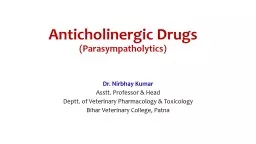

Dr Nirbhay Kumar Asstt Professor amp Head Deptt of Veterinary Pharmacology amp Toxicology Bihar Veterinary College Bihar Animal Sciences University Patna Anticholinergic Parasympatholytic ID: 912433
Download Presentation The PPT/PDF document "Anticholinergic Drugs ( Parasympatholyti..." is the property of its rightful owner. Permission is granted to download and print the materials on this web site for personal, non-commercial use only, and to display it on your personal computer provided you do not modify the materials and that you retain all copyright notices contained in the materials. By downloading content from our website, you accept the terms of this agreement.
Slide1
Anticholinergic Drugs(Parasympatholytics)
Dr. Nirbhay KumarAsstt. Professor & HeadDeptt. of Veterinary Pharmacology & ToxicologyBihar Veterinary College, Bihar Animal Sciences University, Patna
Slide2Anticholinergic (Parasympatholytic) Drugs
These drugs block muscarinic receptors only, so better known as antimuscarinic agents.Mechanism of action of antimuscarinic agents:
Atropine
and related drugs block the cholinergic muscarinic receptors by acting as competitive antagonists of
ACh
or other direct acting cholinergic drugs
.
Slide3Classification of Parasympatholytic Drugs
Classification based on Origin & Structure:
Slide4Classification of Parasympatholytic Drugs
Classification based on Mode of Action:
Slide5Pharmacological Actions of Parasympatholytics
CVS: Small doses of atropine cause an initial temporary bradycardia (agonistic action due to vagal stimulation and/ or momentary stimulation of cardiac muscarinic receptors prior to their blockade). High doses cause
tachycardia.
Atropine
like drugs antagonize the fall in blood pressure caused by choline esters.
Atropine
alone does not affect blood pressure
.
2.
GIT:
Smasmolytic
effect
on GI smooth muscles by preventing the effect of endogenous
ACh
.
Block
the increase in tone and motility of GIT caused by cholinergic drugs.
Rumen
motility is reduced.
GI
secretions including salivation are blocked
.
3.
RT:
Inhibition of bronchial secretions
and
dilatation of bronchi
(temporary relief of
dyspnoea
/ asthma/ heaves in horses
)
.
Slide64. Eye:
Mydriasis and cycloplegia (paralysis of accommodation) following local or systemic use. Mydriasis is due to blockade of cholinergic influence and dominance of adrenergic effect. Cycloplegia
is due to paralysis of ciliary muscle of the lens
.
5.
UT:
Spasmolytic effect
on ureters (useful in the treatment of renal colic) and urinary retention (relaxation of bladder
)
.
6.
Skin:
Anhydrotic action in man (cholinergic) and consequently rise in body temperature but does not prevent sweating in horses (adrenergic).7. CNS: Atropine has no significant effect. Scopolamine in small doses produces depression & excitement and delirium at high doses in cats and dogs.
Pharmacological Actions of
Parasympatholytics
continued…
Slide7Atropine & ScopolamineAtropine
is an alkaloid extracted from the leaves of belladonna plants Atropa belladonna (deadly nightshade), Datura stramonium (Jimson weed) and Hyoscyamus
niger (Henbane).
Scopolamine
is also an alkaloid extracted from the leaves
Hyoscyamus
niger
and
Scopolia
carniolica
Atropa belladonnaDatura stramonium
Hyoscyamus
niger
Scopolia
carniolica
Slide8Atropine continued …
The name “Atropa belladonna”: During the time of the Roman Empire and in the Middle Ages, the deadly nightshade shrub was frequently used to produce an obscure and often prolonged poisoning, prompting Linnaeus to name the shrub Atropa belladonna, after Atropos, the oldest of the three Fates (goddesses) in Greek mythology, who cuts the thread of life. The name belladonna derives from the alleged use of this preparation by Italian women to dilate their pupils
; modern-day fashion models are known to use this same device for visual appeal.
Atropine
is a racemic mixture of d-
hyoscyamine
and l-
hyoscyamine
. The
laevo
form of
hyoscyamine
is biologically active.
Slide9Atropine continued …
Atropine poisoning: Physostigmine is used as it is better able to enter CNS than other parasympathomimetics. It is the central effects of atropine which is lethal.Rabbits
possess an esterase (atropinase
) which hydrolyses atropine and is thereby able to feed on deadly nightshade with freedom without showing any toxic symptom.
The
laevo
isomer of hyoscine is called scopolamine which is the active form. Its main difference from atropine is its slight sedative effect on the CNS at therapeutic dosage.
Slide10Atropinization
Effects of atropine in relation to dose:
Dose
Effects
0.5 mg/kg
Slight cardiac slowing; some dryness of mouth; inhibition of sweating.
1 mg/kg
Definite dryness of mouth; thirst; acceleration of heart, sometimes preceded by slowing; mild dilation of pupils.
2 mg/kg
Rapid heart rate; palpitation; marked dryness of mouth; dilated pupils; some blurring of near vision.
5 mg/kg
All the above symptoms marked. Difficulty in speaking and swallowing; restlessness and fatigue; headache; dry, hot skin; difficulty in micturition; reduced intestinal peristalsis.
10 mg/kg or more
Above symptoms more marked, pulse rapid & weak; iris practically obliterated; vision very blurred; skin flushed, hot dry & scarlet; ataxia; restlessness, excitement, hallucinations and delirium; coma and finally death.
Slide11Atropine:
As
preanaesthetic
As antidote in organophosphate and carbamate poisoning (0.2 to 0.5 mg/kg : 1/4
th
of the total dose should be given
i.v.
and rest by
i.m
. route).
For relief of heaves in horses.
Eye drops (1%) – during eye examination.
Homatropine
:
2 – 5 % solution topically in the eye for
ophtalmological
use (
mydriatic
or
cycloplegic
). Its effects are of shorter duration as compared to those of atropine which causes persistent
mydriasis
and
cycloplegia
.
Glycopyrrolate
:
Preanaesthetic
.
[NB:
Alternate use of a
mydriatic
(e.g. atropine) and a miotic (e.g. physostigmine 0.5%) can be used to prevent adhesions involving the iris.]
Therapeutic Uses of
Parasympatholytics
Slide12Thank You